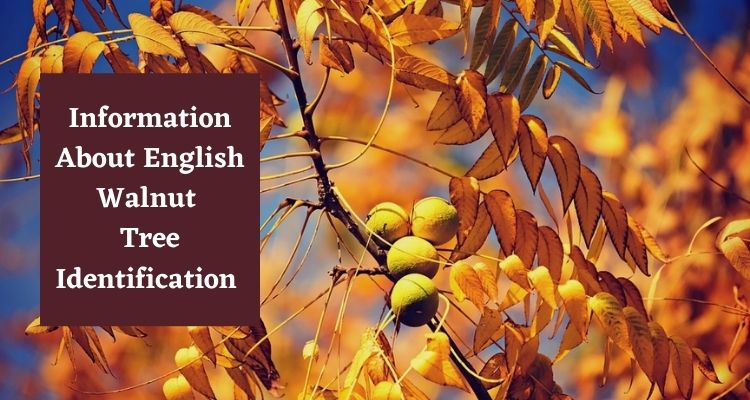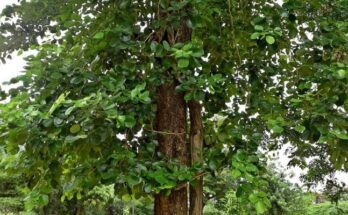|
Getting your Trinity Audio player ready...
|
About Walnut Tree
English walnuts have a smooth olive-colored at youth and become dark gray, rough, and deeply cracked when mature. It grows to a maximum of 65 feet and is an important walnut because this is where the walnuts sold commercially come from. It is also called the walnut or the Persian walnut, as the natural habitat of this tree is in southern Europe.
It produces round drupes that turn dark black or brown when they fall to the ground. In Europe, their stone fruits are marinated and are considered a local delicacy. It has pinnate leaves with a solitary leaflet on top. Compared to butternut and black walnuts, the English walnut has fewer leaves.
English Walnut Tree Identification

1. Wood– English walnut is smooth and soft with fewer grooves. However, English walnut takes years to mature.
2. Shell– English walnut has a thin, soft shell that makes it easy to break. After breaking, the nut can be easily removed from the shell of the English walnut, while the nut of the black walnut is much more difficult to remove when opening.
3. Flavor– English walnut has a more appealing taste and is mainly used for baking, cooking, ice cream making, and roasting because of its unique taste.
Here are 8 Types of Walnut Tree
1. Andean Walnuts Tree

As the name suggests, this slow-growing walnut comes from the Andes, particularly Colombia, Ecuador, and Peru. It is also called black cedar and columbine walnut. They are characterized by their red interior wood, which is a highly valued wood in the wood industry.
2. Arizona Black Walnut Tree

This is relatively small compared to other walnuts, with a maximum height of 40 to 50 feet and a spread of up to 65 feet. It is characterized by its small nuts with an earthy taste. Its bark is deeply fissured, gray-brown, with horizontal furrows and flat ridges. Its leaves are pinnate, elongated, and pointed.
3. Black Walnut Tree

As the name suggests, black walnut has a deep, cracked rind darker than other species. It also bears diamond-shaped ridges. Black walnut also called the American walnut and can live up to 130 years. It produces catkins in summer, and the stems and leaves smell of citrus fruits.
4. Brazil Walnuts Tree

It grows in climate zones 10-11 and is native to Argentina and Bolivia. It is considered to be the toughest walnut. Although it rarely grows in the northern hemisphere, it is grown as an ornamental plant in more tropical climates in the United States and Europe.
5. Butternut or White Walnut Tree

It is characterized by its smooth, whitish-gray bark, which, when ripe, becomes rough and with deeper cracks. They are smaller than black walnut, only reaching a maximum of 66 feet, and grow in cooler, more temperate climates. Although they thrive in full sun, butternut can’t take too much heat. Butternut seeds are more buttery than earthy, hence the name. In contrast to black walnut, butternut lies softly on the ground.
6. California Black Walnut Tree

It is the shrubby version of the black walnut that grows on one or more stems. It thrives in warm climates to a height of 20 to 60 feet. Its leaves are smooth, glossy, and olive green. It has 10 to 20 pairs of leaflets per branch. It comes from Southern California with sweet, earthy walnuts.
7. Little Nut Tree

Also called the Texas Black Walnut, it is more of a large bush than a tree. This nut grows up to 30 feet tall and thrives in warm climates. Its fruits can be edible, but it is insignificant as it is valued more for its wood. It has drooping branches and a rounded crown at the top. Their natural habitats would be river beds and canyons.
8. Northern California Black Walnut (Juglans Hindsii) Tree

It grows from a single stem to a height of 60 feet. It’s short and bulky with a crown that is wider than the tree. Their foliage consists of 13 to 21 pairs of leaflets per branch, and they are unique for their thick texture and jagged edges.
Here are 4 Benefits of Walnut Tree

1. Medicinal uses: Different parts of the tree have medicinal uses. Leaves and bark have alterative, laxative, astringent, and cleansing properties and treat skin diseases.
2. The green husk’s juice boiled with honey is a good gargle for your sore throats.
3. Walnut oil can be used for colic and skin diseases.
4. Walnut leaves: Its leaves can be used to make wine.
Conclusion
Walnut trees produce large numbers of walnuts, which is amazing as adding nuts to your diet has an incredible number of health benefits. Considered the healthiest natural food globally for the heart, walnuts are rich in specific amino acids that improve heart function and maintain healthy cholesterol levels. Comment below if you have any queries or suggestions below.



